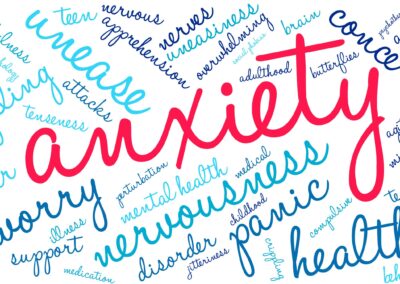There’s no denying that industries and organizations around the globe are experiencing trying times at the moment. Three years into the coronavirus pandemic, and still facing uncertainty around the globe, studies have shown increases in stress and anxiety among both adults and children. Some are even experiencing symptoms of post-traumatic stress, with some experts naming this syndrome “post-COVID stress disorder” or “pandemic PTSD.”
Anxiety is a natural response to an individual perceiving that he or she is under threat. It’s the feeling a person has when they are worried, tense or afraid. Apart from immediate danger, anxiety is often driven by the thought of things that may happen, or which could happen in the future.
In addition to a general sense of worry, signs of anxiety can include:
- Feeling nervous, restless or tense
- A sense of impending danger
- Panic attacks
- Increased heart rate
- Hyperventilation
- Sweating
- Trembling
- Weakness, tiring easily
- Trouble concentrating
- Mental fixation
- Insomnia
While the post-COVID environment led to some industries hiring workers at a breakneck pace, current economic trends are now accompanied by significant numbers of layoffs. This has thrown into question the stability of some industries which had been leading economic growth for quite some time. It has also caused uneasiness among job seekers and workers alike.
Losing a job, the prospect of losing one’s livelihood, or being unable to find work when it’s needed are basic survival concerns. As such, these scenarios are sure-fire ways of cultivating high levels of anxiety in any individual.
Contradicting Economic Indicators and Confusion
Despite months of record-low unemployment rates, press outlets are now reporting that workers are increasingly anxious about their job security due to the recent wave of layoffs at dozens of companies including Goldman Sachs, Microsoft and Facebook’s parent company, Meta. In mid-March, Meta announced plans to lay off at least 10,000 employees, its second major round of job cuts in the last six months. According to a recent Harris Poll/Justworks survey of over 1,000 working Americans, more than 40% of U.S. employees are concerned about losing their jobs, and 47% say they have changed their behavior at work to avoid being laid off.
According to Forbes, insecurity over one’s job can negatively impact focus and motivation, as well as potentially leading to mental health problems such as anxiety or depression. This is compounded by the fact that layoff anxiety can give rise to a cascade effect, with increasing anxiety compromising work performance, thereby leading to more anxiety, and so on. The feeling of overwhelm can become a self-fulfilling prophecy when it affects one’s performance to the degree that the employer begins to see the employee as a liability.
The phenomenon has definitely not gone unnoticed by experts, pundits and onlookers. Job insecurity and layoff anxiety have become prominent topics in the press, and do not look likely to diminish anytime soon. This quote from a September 2022 article may resonate even more today than when it was published. .
“The Great Resignation has given way to The Great Apprehension, as more than half of U.S. companies actively reduce headcount or plan to in the coming months. As a result, layoff anxiety is palpable among workers. More than 39,000 workers have been let go in the U.S. tech sector alone as of August, including employees at industry titans like Peloton, Shopify, and Netflix.” – Harvard Business Review
A recent article for the BBC points out that while historically, layoffs have been part of the cycles of an ebbing and flowing economy, experts say that this wave of layoffs is notable for a number of reasons. Among these are their scope and scale in light of the underlying economic fundamentals showing improvement, improving workplace culture and employee value proposition (EVP) across many industries.
Job cuts “can have an immediate effect on wellness” says the BBC, with research indicating that being laid off increases the risk of a host of health conditions. Pointing to one of the most comprehensive summaries of more than 300 studies on this subject, they claim that unemployed people are more distressed, less satisfied with their lives, marriages and families and more likely to report psychological problems than the employed. Protracted bouts of anxiety over job loss or the anticipation thereof can lead to attendant physical problems, such as insomnia, gastrointestinal (GI) issues and even cardiopulmonary issues (mayoclinic.org). Layoffs and extended unemployment have been linked to a much higher risk of suicide and higher rates of mortality.
Traditional Layoff Anxiety Approaches in the News
As a result, a lot of the ink that’s coming out on the topic has to do with methods by which workers can alleviate layoff anxiety. These include everything from mental exercises that have their roots in behavioral therapy, to practical job-seeking and damage control strategies, to action steps workers can take to avoid a layoff or prepare themselves in case one does occur. Other traditional approaches include relaxation techniques such as meditation, Yoga, and exercise.
Of course, some individuals who have been significantly impacted do turn to medicine to address their layoff anxiety. The amount of money spent on anti-anxiety medications annually is in the billions of dollars, and has risen dramatically as a result of the COVID-19 pandemic. Between March 2019 and March 2020, U.S. prescriptions for anti-anxiety medications jumped from 8.8 million to 9.7 million, and during the week ending March 15th, 2020, 78% of all antidepressant, anti-anxiety and anti-insomnia prescriptions filled were for new prescriptions (Market Watch).
BreathConductor™ for Managing Layoff Anxiety
It has been established, scientifically, that chronic activation of the natural stress response impairs overall health and well-being, and that the easiest and most effective way to reverse this and shift into a more relaxed state is to regulate one’s breathing. Various forms of breathwork have long been advocated by patients and practitioners in combating anxiety. Like many other paradigms that are used to address anxiety however, the practice has lacked a standardized, user-friendly approach and scientific refinement.
BreathConductor™ from Muvik Labs is a digital therapy solution for stress resilience that allows the user to relieve their anxiety, manage stress and improve sleep with personalized, self-guided breathing sessions. In addition to empowering individuals to effectively manage their anxiety and its negative side effects, BreathConductor™ offers health providers a simple tool to augment mental health treatment plans. An added benefit is that it also provides organizations with a cost-effective means to enhance employees’ well-being while increasing productivity.
Using a precision respiration infrastructure, health providers and instructors can brand and add additional personalization to their patient/client experience while monitoring engagement. BreathConductor™ can be used independently or in concert with your other anxiety methods to reduce stress, improve sleep, and manage your well-being.
To learn more about how BreathConductor™ can assist you, or your team Contact Us here.
#anxiety #anxietyrelief #stress #breathe #breathwork #relax #relaxationtechniques #anxietyhelp




